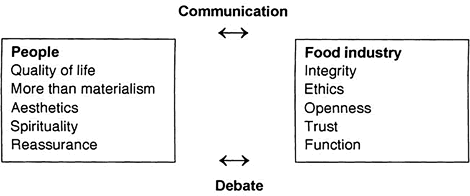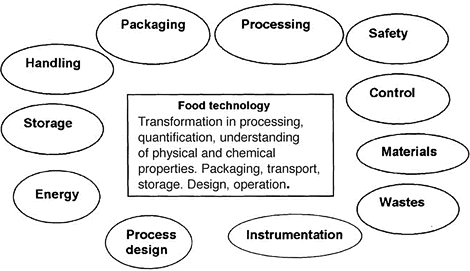FOOD
PRODUCT DEVELOPMENT
Mary Earle, Richard Earle and Allan Anderson |
| Loading
|
|
||||
|
|
Part 2, Chapter 2
Developing an innovation strategy 2.1.1 Sensing the possibilities for innovations In sensing the possibilities, it is important to study the major changes that are taking place or predicted in society, in technology, food system, the marketplace and the consumers. Only then can the possible company initiatives be created. Social and political changes cause changes in the food industry or may even prevent innovations in the food industry. Eating food is a universal activity and therefore the food industry perhaps more than any other industry is enmeshed in the social and political systems in every country. Society changes in many ways as shown in Table 2.1. Table 2.1 Changes in society leading to food innovations
Source: After Earle, 1997. The political systems and their attitudes to the food industry also change with societal changes. In 1982, Throdahl suggested that the most important govern- mental method of encouraging innovation in the food industry was to reduce the adverse impact of regulations on innovation but did add 'without sacrifice of social objectives'. This has been the food industry's dilemma for the past 100 years and even earlier - innovation with or without consideration of society. The political system itself can encourage or discourage innovation, by placing trade barriers or subsidies which encourage local food production and discourage imports. National policies, based on societal concerns, needs and wills, can create a reactive environ ment for innovation in the food industry. In looking for innovation possibilities, food companies need to be aware of changes in societal attitudes that fuel political changes as well as food changes. The social and related political changes have caused food innovation in the past and will continue to do so in the future. Food companies need to have methods of monitoring social changes and predicting future changes (Earle and Earle, 2000). There needs to be greater recognition of human values in developing innovation strategies as outlined in Fig. 2.4.  Fig. 2.4 Human values and the food industry (Source: From Earle and Earle, Building the Future on New Products, © LFRA Ltd, 2000, by permission of Leatherhead Food RA, Leatherhead, UK).
Technological innovation spans a broad spectrum of areas from the new crop and the newly farmed fish, through new refining methods, new preservation methods, new manufacturing methods, new distribution methods, new retailing methods, new cooking and preparation methods. But it also includes changes in technologies of other industries, particularly in those related to the food industry such as the processing technologies in the pharmaceutical and chemical industries, in the home appliance technologies and in the electronic and information technologies. There also needs to be consideration of new scientific knowledge that may be the basis for new technologies in the future. Companies, even very large food companies, are often based on one technology; for example emulsion technology may be the main emphasis and this covers a very wide spectrum of foods from margarine to mayonnaise to ice cream to sausages. Their knowledge is extensive in this one technology and it is often more successful to seek innovation from this basis. When going to a new technology, a great deal of knowledge has to be found as quickly as possible; this means building up resources either by learning or by buying a company already using the technology. It is important for companies to select a basic technology that can lead to many different types of products to satisfy different markets. Some of the technological areas for innovation (Rizvi et al., 1993) are shown in Fig. 2.5.  Fig. 2.5 Technological areas for innovation
Changes in the structure of the food system are also an important source of ideas for innovation possibilities. There are often changes in the importance of the various parts - production, ingredient processors, food manufacturers, retailers, food service - and the pressure for innovation moves from one section to another. Recently there has been increased new product activity in the ingredients industry, which is being transmitted to both producers and food manufacturers. Both vertical and horizontal integration have occurred in the last 50 years, and caused major innovations. For example vertical integration in the chicken industry led to chicken as major meat, and to the development of many new products; horizontal integration led to many new products in the baking industry. A change in one part of the food system leads to new products in other parts. In particular, innovations in the primary producing industries produce new ingredients, which then advance to new consumer products. Canola seed was developed with low erucic acid, and these seeds were used to produce oil with high polyunsaturated/low saturated fatty acids, and the oil was then used to develop oil-based consumer products which were more attractive nutritionally. The food system changes slowly. During the last century changes were incremental with some major changes, and the radical changes were well spaced. This may be caused by:  maturity of the industry
- compared with the innovative industries such maturity of the industry
- compared with the innovative industries suchas electronics, it is more difficult to invent new products;  consumers - many are cautious and suspicious in judging new foods; consumers - many are cautious and suspicious in judging new foods; food consumers change slowly unless they recognise marked benefits in the new product, and new benefits are more difficult to design than in other industries, for example information technology;  biological product development - it takes time to develop a new plant, biological product development - it takes time to develop a new plant, a new animal, a new fish, and even a new safe process, and these are the basis of the radical changes. Because of the expense of these developments, they were mainly funded by governments in the past (Earle and Earle, 1997), which also led to slowness;  marginal returns on new food products - compared with other industries, marginal returns on new food products - compared with other industries, for example the pharmaceutical industry, the profits on new food products are small. So it may be that this has been the most suitable innovation method - mostly incremental product changes, some major changes and a few radical changes. But with today's high rate of technological change in other industries, there may be change in the rate of innovation in the future. The knowledge and understanding of technology in the total food system is continuing to grow rapidly and, if this is recognised by the industry, it will impact on new products, new processes and new manufacturing systems but more important on the consumers' and society's attitudes and behaviour towards food. However, if acceptance by the consumers is to be widespread and willing, then they must see obvious overall benefits to themselves; this needs, among other things, full and clear information. A striking lesson in the difficulties that may arise is to be seen in the introduction of genetically engineered foods. The bundle of products and services that the food company calls an innovation is now in the eyes of the consumers an experience, which they hope is safe and enjoyable (Pine and Gilmore, 1998). The food industry has gone through: Commodities Innovation occurs today at all these levels in the various parts of the food system.
Marketplace changes provide a rich source of innovation possibilities (Earle, R.L. and Earle, M.D., 1999). There needs to be searching for long-term possibilities, as well as tactical thinking for the immediate marketing plans. Four areas to consider when looking for long-term marketing possibilities are:  international comparisons; international comparisons;
 product and service developments; product and service developments;
 market specialisation; market specialisation;
 new distribution methods. new distribution methods.
Looking internationally, it is important to take a broad look over many markets and compare them. The home market in the USA or Europe may be static, but markets in Asia are increasing rapidly. Alternative possibilities are either in the home market to increase a market share or to have higher value products, or in the new market to relaunch the old basic products. As can be seen with McDonald's and Coca-Cola, relaunching on a new market is successful in the long term, but there is a need to keep the home market viable as the basis for the new venture. The reverse also occurs: products on an overseas market can produce ideas for the new product in the home market. Changing the ratio of product to services is another way of identifying innovations. Once the new product was the main innovation in consumer marketing but increasingly service has become important. How far does the food manufacturing company go in providing services for the consumer; how far does the ingredients company go in providing services for the food manufacturer? Certainly innovation can be found; for example in food service providing the materials and the recipe for the dish opens up a whole range of new products to be supplied to small restaurants; providing complete chilled meals, ready-to- heat, in supermarkets again leads to many new products. Market specialisation has gained increasing recognition in searching for innovations. In the past the food companies tried to provide a wide range of foods, and their innovation growth was often achieved by buying or amalgamating with other companies. Today should marketing be more focused and the innovations aimed at specific target markets? In other words, should variations of a product be developed for different market segments, so that the new products are more focused on the people in that market? Distribution has always been an area for major new developments - from the grocer's shop to the supermarket to the mega-market - and one would predict that there are going to be major changes in the next ten years with the introduction of e-commerce and other uses of the Internet. The information age is certainly having a strong effect on all aspects of marketing technology - the distribution system, the places for selling food, the communications, the promotion, the sales methods. New food products will certainly come from the four consumer trends: using the Internet to buy food, food shopping as entertainment, food shopping for freshness and food shopping for health, all of which will affect the distribution system (Earle and Earle, 2000). In searching for the long-term market possibilities, the basic research is to study the consumers and in the case of the food ingredients company also their immediate customers. There is a need to take a broad look at the possible consumers and their future needs, wants and behaviour (Earle and Earle, 2000). The research is about people - how they think, feel and behave, and why they think, feel and behave in these ways, and then to relate this to their needs in future products as shown in Box 2.1 (Hedges, 1969).
It is interesting that this paper was published over 30 years ago, and how many of the predictions have become reality. An interesting question today is: are the consumers' knowledge and attitudes pushing the food industry towards the product quality standards of the pharmaceutical industry, guaranteeing the safety and the effectiveness of the food products? What innovation possibilities does this uncover?
|
|
 |